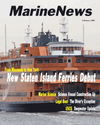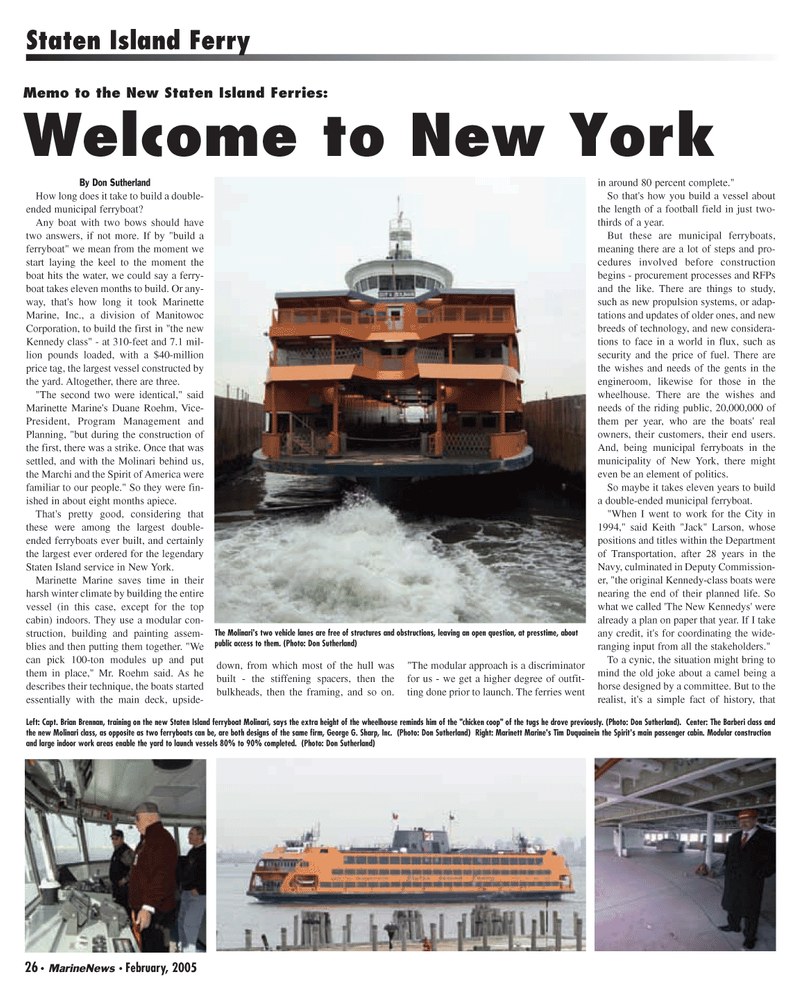
Page 26: of Marine News Magazine (February 2005)
Read this page in Pdf, Flash or Html5 edition of February 2005 Marine News Magazine
26 • MarineNews • February, 2005
By Don Sutherland
How long does it take to build a double- ended municipal ferryboat?
Any boat with two bows should have two answers, if not more. If by "build a ferryboat" we mean from the moment we start laying the keel to the moment the boat hits the water, we could say a ferry- boat takes eleven months to build. Or any- way, that's how long it took Marinette
Marine, Inc., a division of Manitowoc
Corporation, to build the first in "the new
Kennedy class" - at 310-feet and 7.1 mil- lion pounds loaded, with a $40-million price tag, the largest vessel constructed by the yard. Altogether, there are three. "The second two were identical," said
Marinette Marine's Duane Roehm, Vice-
President, Program Management and
Planning, "but during the construction of the first, there was a strike. Once that was settled, and with the Molinari behind us, the Marchi and the Spirit of America were familiar to our people." So they were fin- ished in about eight months apiece.
That's pretty good, considering that these were among the largest double- ended ferryboats ever built, and certainly the largest ever ordered for the legendary
Staten Island service in New York.
Marinette Marine saves time in their harsh winter climate by building the entire vessel (in this case, except for the top cabin) indoors. They use a modular con- struction, building and painting assem- blies and then putting them together. "We can pick 100-ton modules up and put them in place," Mr. Roehm said. As he describes their technique, the boats started essentially with the main deck, upside- down, from which most of the hull was built - the stiffening spacers, then the bulkheads, then the framing, and so on. "The modular approach is a discriminator for us - we get a higher degree of outfit- ting done prior to launch. The ferries went in around 80 percent complete."
So that's how you build a vessel about the length of a football field in just two- thirds of a year.
But these are municipal ferryboats, meaning there are a lot of steps and pro- cedures involved before construction begins - procurement processes and RFPs and the like. There are things to study, such as new propulsion systems, or adap- tations and updates of older ones, and new breeds of technology, and new considera- tions to face in a world in flux, such as security and the price of fuel. There are the wishes and needs of the gents in the engineroom, likewise for those in the wheelhouse. There are the wishes and needs of the riding public, 20,000,000 of them per year, who are the boats' real owners, their customers, their end users.
And, being municipal ferryboats in the municipality of New York, there might even be an element of politics.
So maybe it takes eleven years to build a double-ended municipal ferryboat. "When I went to work for the City in 1994," said Keith "Jack" Larson, whose positions and titles within the Department of Transportation, after 28 years in the
Navy, culminated in Deputy Commission- er, "the original Kennedy-class boats were nearing the end of their planned life. So what we called 'The New Kennedys' were already a plan on paper that year. If I take any credit, it's for coordinating the wide- ranging input from all the stakeholders."
To a cynic, the situation might bring to mind the old joke about a camel being a horse designed by a committee. But to the realist, it's a simple fact of history, that
Staten Island Ferry
Memo to the New Staten Island Ferries:
Welcome to New York
The Molinari's two vehicle lanes are free of structures and obstructions, leaving an open question, at presstime, about public access to them. (Photo: Don Sutherland)
Left: Capt. Brian Brennan, training on the new Staten Island ferryboat Molinari, says the extra height of the wheelhouse reminds him of the "chicken coop" of the tugs he drove previously. (Photo: Don Sutherland). Center: The Barberi class and the new Molinari class, as opposite as two ferryboats can be, are both designs of the same firm, George G. Sharp, Inc. (Photo: Don Sutherland) Right: Marinett Marine's Tim Duquainein the Spirit's main passenger cabin. Modular construction and large indoor work areas enable the yard to launch vessels 80% to 90% completed. (Photo: Don Sutherland)
MN FEB05 (25-33).qxd 1/26/2005 4:59 PM Page 26

 25
25

 27
27
